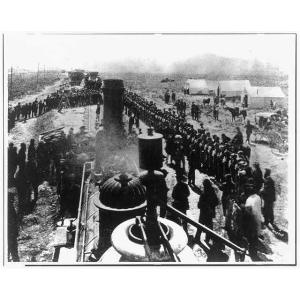This is Eli King from the Center for Mathematics & Science Education at the University of Mississippi with an exciting announcement! But first…
Did you enjoy eating sweet potatoes this Thanksgiving? Americans purchase around 50 million pounds of sweet potatoes every Thanksgiving, and many of those potatoes are harvested from fields right here in Mississippi! The sweet potato plays an important role in Mississippi's agricultural history. But, did you know that Laurel, MS, was the home of an innovative federally-funded plant in the 1930s, tasked with engineering methods to extract starch from sweet potatoes? The Library of Congress hosts a collection of images from the groundbreaking plant, as well as newspaper articles from across the nation that reported the plant's contributions to industry and the American economy.
Join us for the STEM Teaching with Embedded Primary Sources (STEPS) workshop to learn how to access, analyze, and use historical artifacts from the Library of Congress to bring mathematics, science, and other STEM-related subjects to life for your students! Registration for the December 18-19, 2024, workshop at the Lauren Rogers Museum of Art in Laurel, MS, is closing soon! If you are interested in this workshop, or know of any educator (formal or informal) that would be, you can learn More and register at: https://olemiss.edu/cmse/professional-learning/
Access the Laurel, MS, starch plant collection: https://www.loc.gov/search/?fa=partof:lot+1655
The following album contains various photographs, caricatures, snippets of newspapers from the time, and a court report involving an African American male on trial for murder in Missisisppi. 6 - 8 Social Studies/History
Standards: MSCCRS (2018)
11th Grade: US History: 1877 to the Present
US History Primary and Secondary source materials on the transcontinental railroad, focusing on its construction and completion; as well as economic, cultural, and environmental impact on wildlife and native American tribes. This topic sits at a pivotal point of many US History themes, allowing these primary sources to be applied to the topics of Westward Expansion, the Civil War, and Reconstruction.
The abundance of primary and secondary source materials allows teachers to easily incorporate primary sources into any part of a history lesson, either as a supporting artifact or utilized as the main part of a lesson. Many of the listed sources would be engaging lesson launches/bellringers. The many images are useful for visual discovery as many parts of the railroad's construction was sketched, photograph, or mapped. There are also many primary source writings that students can read and practice historic inquiry, analyzing source, contextualizing, corroborating, as well as doing close readings of various documents.
State Standard (7.9): "Investigate the impact of the Renaissance and the Reformation on Europe. (Strands: Civics, Civil Rights, Geography, History, Economics)"
State Objective (addressed in this album): "Explain the influence of the idea of humanism on the development of the Renaissance."
Testimonials
- I love that there is new info on the site daily!
- I had a wonderful time working with the Library of Congress and learning about all of the resources at my fingertips!
- The TPS Teachers Network has an equal exchange of ideas. You know it's not a place where you're being judged.
- My colleagues post incredibly fine resources and ideas....the caliber of the suggestions and resources make me feel that I take a lot from it. It's a takeaway. And I hope that I can give back as much as I get.
- Going into this school year, I have a fantastic new resource for my own instruction and to share with my colleagues!
- I am very glad that I discovered the TPS Teachers Network through RQI. Great resources can be hard to find out there on the internet!

























